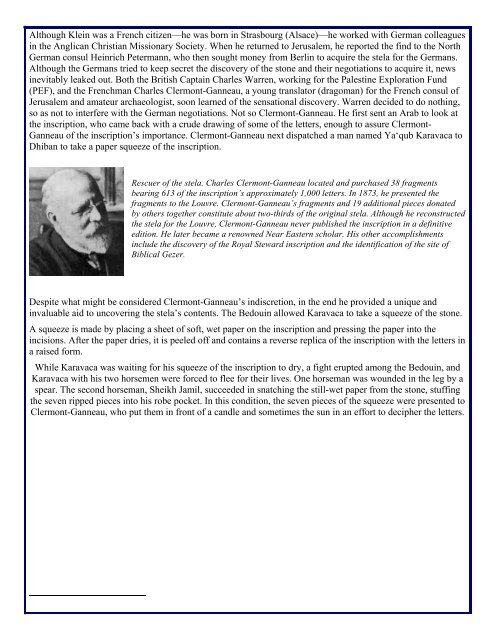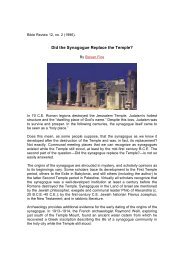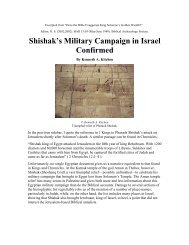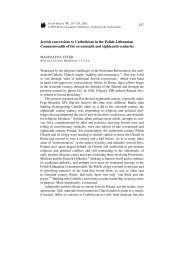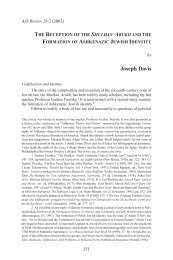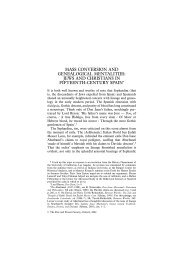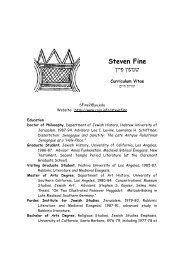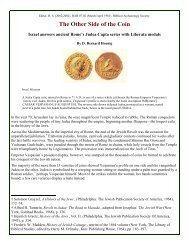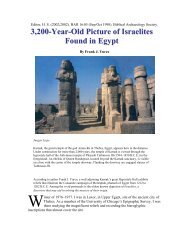“House of David” Restored in Moabite Inscription
“House of David” Restored in Moabite Inscription
“House of David” Restored in Moabite Inscription
You also want an ePaper? Increase the reach of your titles
YUMPU automatically turns print PDFs into web optimized ePapers that Google loves.
Although Kle<strong>in</strong> was a French citizen—he was born <strong>in</strong> Strasbourg (Alsace)—he worked with German colleagues<br />
<strong>in</strong> the Anglican Christian Missionary Society. When he returned to Jerusalem, he reported the f<strong>in</strong>d to the North<br />
German consul He<strong>in</strong>rich Petermann, who then sought money from Berl<strong>in</strong> to acquire the stela for the Germans.<br />
Although the Germans tried to keep secret the discovery <strong>of</strong> the stone and their negotiations to acquire it, news<br />
<strong>in</strong>evitably leaked out. Both the British Capta<strong>in</strong> Charles Warren, work<strong>in</strong>g for the Palest<strong>in</strong>e Exploration Fund<br />
(PEF), and the Frenchman Charles Clermont-Ganneau, a young translator (dragoman) for the French consul <strong>of</strong><br />
Jerusalem and amateur archaeologist, soon learned <strong>of</strong> the sensational discovery. Warren decided to do noth<strong>in</strong>g,<br />
so as not to <strong>in</strong>terfere with the German negotiations. Not so Clermont-Ganneau. He first sent an Arab to look at<br />
the <strong>in</strong>scription, who came back with a crude draw<strong>in</strong>g <strong>of</strong> some <strong>of</strong> the letters, enough to assure Clermont-<br />
Ganneau <strong>of</strong> the <strong>in</strong>scription’s importance. Clermont-Ganneau next dispatched a man named Ya‘qub Karavaca to<br />
Dhiban to take a paper squeeze <strong>of</strong> the <strong>in</strong>scription.<br />
Rescuer <strong>of</strong> the stela. Charles Clermont-Ganneau located and purchased 38 fragments<br />
bear<strong>in</strong>g 613 <strong>of</strong> the <strong>in</strong>scription’s approximately 1,000 letters. In 1873, he presented the<br />
fragments to the Louvre. Clermont-Ganneau’s fragments and 19 additional pieces donated<br />
by others together constitute about two-thirds <strong>of</strong> the orig<strong>in</strong>al stela. Although he reconstructed<br />
the stela for the Louvre, Clermont-Ganneau never published the <strong>in</strong>scription <strong>in</strong> a def<strong>in</strong>itive<br />
edition. He later became a renowned Near Eastern scholar. His other accomplishments<br />
<strong>in</strong>clude the discovery <strong>of</strong> the Royal Steward <strong>in</strong>scription and the identification <strong>of</strong> the<br />
site <strong>of</strong><br />
Biblical Gezer.<br />
Despite what might be considered Clermont-Ganneau’s <strong>in</strong>discretion, <strong>in</strong> the end he provided a unique and<br />
<strong>in</strong>valuable aid to uncover<strong>in</strong>g the stela’s contents. The Bedou<strong>in</strong> allowed Karavaca to take a squeeze <strong>of</strong> the stone.<br />
A squeeze is made by plac<strong>in</strong>g a sheet <strong>of</strong> s<strong>of</strong>t, wet paper on the <strong>in</strong>scription and press<strong>in</strong>g the paper <strong>in</strong>to the<br />
<strong>in</strong>cisions. After the paper dries, it is peeled <strong>of</strong>f and conta<strong>in</strong>s a reverse replica <strong>of</strong> the <strong>in</strong>scription with the letters <strong>in</strong><br />
a raised form.<br />
While Karavaca was wait<strong>in</strong>g for his squeeze <strong>of</strong> the <strong>in</strong>scription to dry, a fight erupted among the Bedou<strong>in</strong>, and<br />
Karavaca with his two horsemen were forced to flee for their lives. One horseman was wounded <strong>in</strong> the leg by a<br />
spear. The second horseman, Sheikh Jamil, succeeded <strong>in</strong> snatch<strong>in</strong>g the still-wet paper from the stone, stuff<strong>in</strong>g<br />
the seven ripped pieces <strong>in</strong>to his robe pocket. In this condition, the seven pieces <strong>of</strong> the squeeze were presented to<br />
Clermont-Ganneau, who put them <strong>in</strong> front <strong>of</strong> a candle and sometimes the sun <strong>in</strong> an effort to decipher the letters.


